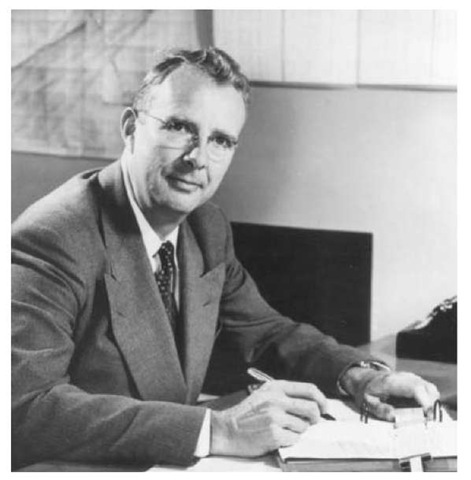In his first years as a research physicist at the University of California at Berkeley in the 1930s, Luis Alvarez earned the title "prize wild idea man," which acknowledged both his wide-ranging investigations and his ability to identify important questions in need of solutions. A member of the Manhattan Project that developed the atomic bomb during World War II, Alvarez followed the Enola Gay, the plane that dropped the atomic bomb on Hiroshima, Japan, in an another B-29 bomber from which he witnessed the destruction of Hiroshima. Alvarez also modified the bubble chamber technique invented by University of Michigan physicist Donald Glaser for use in conjunction with particle accelerators to identify previously unknown elementary particles. This work earned him the Nobel Prize in physics in 1968, though he never rested on these laurels, remaining active and innovative in physics for the next 20 years.
A member of the Manhattan Project, Luis Alvarez witnessed the destruction of Hiroshima from a B-29 bomber that followed the Enola Gay, the plane that dropped the atomic bomb.
Alvarez was born on June 13, 1911, in San Francisco, California, to Dr. Walter Clement Alvarez, a research physiologist at the University of California at San Francisco, and Harriet Skidmore Smythe, an Irish woman whose family instituted a missionary school in Foochow, China. Alvarez had two children, Walter and Jean, with his first wife, Geraldine Smithwick, a fellow University of Chicago student, but their relationship ended over the strain of wartime separation. Alvarez had two more children, Donald and Helen, with his second wife, Janet Landis, whom he married in 1958.
Alvarez entered the University of Chicago in 1928, earned his B.S. in 1932, and graduated in 1936 with his Ph.D. in physics. He appreciated his graduate adviser, Nobel laureate Arthur Compton, not for guiding him but rather for staying out of his way while he immersed himself in his research. At UC Berkeley he conducted research alongside two other Nobel laureates, Ernest Orlando Lawrence and Felix Bloch.
Alvarez earned his reputation as the wild idea man quickly at UC Berkeley with three significant discoveries in the 1930s. Within his first year there he discovered how atomic nuclei decayed and orbital electrons absorbed them, a process known as K-electron capture. He also invented a mercury vapor lamp with a student, and with Bloch, he developed a process for determining the magnetic moment of neutrons by slowing their motion in a beam. In the early 1940s he conducted research for the military at the Massachusetts Institute of Technology on radio detecting and ranging systems, developing three new types of radars in three years.
Alvarez never suffered from guilt over his role in the development of the atomic bomb and continued to support nuclear technology, as he believed the benefits far outweighed the problems. After the war Alvarez devoted his research to particle physics, building larger and faster particle accelerators. He transformed Glaser’s bubble chamber design to use liquid hydrogen instead of diethyl ether as the liquid through which the particles passed, leaving their bubble tracks. By this method he discovered dozens of new elementary particles.
In the final years of his career, Alvarez projected high-energy muon rays (the subatomic particles of cosmic radiation) at King Chep-hren’s pyramid in Gaza, Egypt, to determine that it had no secret chambers. The Warren Commission called upon his physics expertise to verify the fact of a lone assassin in the murder of President John F. Kennedy. Finally, he teamed up with his son, UC Berkeley geologist Walter Alvarez, to hypothesize that the dust created by the earth’s collision with an asteroid caused the "winter" that exterminated dinosaurs, a widely accepted theory based on iridium deposits in Italian sedimentary rock.
Alvarez remained on the faculty of UC Berkeley until his retirement in 1978. His 1968 Nobel Prize and the 22 patents he held on his inventions attested to the significance of his work. He died of cancer on September 1, 1988, in Berkeley, California.

